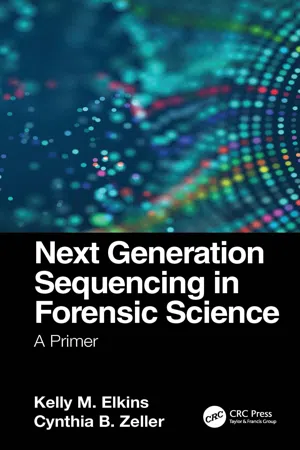
Next Generation Sequencing in Forensic Science
A Primer
Kelly M. Elkins, Cynthia B. Zeller
- 162 pagine
- English
- ePUB (disponibile sull'app)
- Disponibile su iOS e Android
Next Generation Sequencing in Forensic Science
A Primer
Kelly M. Elkins, Cynthia B. Zeller
Informazioni sul libro
Next Generation Sequencing in Forensic Science: A Primer addresses next generation sequencing (NGS) specific to its application to forensic science. The first part of the book offers a history of human identity approaches, including VNTR, RFLP, STR, and SNP DNA typing. It discusses the history of sequencing for human DNA typing, including Sanger sequencing, SNaPshot, pyrosequencing, and principles of next generation sequencing. The chapters present an overview of the forensically focused AmpliSeq, ForenSeq, Precision ID, PowerSeq, and QIAseq panels for human DNA typing using autosomal, Y and X chromosome STRs and SNPs using the MiSeq FGx and Ion Torrent System. The authors outline the steps included in DNA extraction and DNA quantitation that are performed prior to preparing libraries with the NGS kits.
The second half of the book details the implementation of ForenSeq and Precision ID to amplify and tag targets to create the library, enrich targets to attach indexes and adaptors, perform library purification and normalization, pool the libraries, and load samples to the cartridge to perform the sequencing on the instrument. Coverage addresses the operation of the MiSeq FGx and Ion Chef, including creating a sample list, executing wash steps, performing NGS, understanding the run feedback files from the instrument, and troubleshooting. ForenSeq and Precision ID panel data analysis are explained, including how to analyze and interpret NGS data and output graphs and charts. The book concludes with mitochondrial DNA (mtDNA) sequencing and SNPs analysis, including the issue of heteroplasmy. The final chapters review forensic applications of microbial DNA, NGS in body fluid analysis, and challenges and considerations for future applications.
FEATURES
-
- Focuses on human identification using traditional and NGS DNA typing methods targeting short tandem repeats (STRs)
-
- Applies the technology and its application to law enforcement investigations and identity and ancestry single nucleotide polymorphisms (SNPs) for investigational leads, mass disaster, and ancestry cases
-
- Presents the underlying principles of NGS in a clear, easy-to-understand format for practitioners and students studying DNA in forensic programs
This is the first book to prepare practitioners to utilize and implement this new technology in their lab for casework, highlighting early applications of how NGS results have been used in court. The book can be utilized for upper-level undergraduate and graduate students taking courses focused on NGS concepts. Readers are expected to have a basic understanding of molecular and cellular biology and DNA typing.
Domande frequenti
Informazioni
1 History of DNA-Based Human Identification in Forensic Science
1.1 Introduction
1.2 Application of DNA Sequencing to Human DNA
| Year | Advance |
|---|---|
| 1953 | Rosalind Franklin records X-ray autoradiographs of crystallized DNA fibers and deduces basic features including that the structure was helical with the phosphates on the outside and its basic dimensions of DNA strands and publishes with Raymond Gosling in Nature |
| 1953 | James Watson and Francis Crick solve three-dimensional structure of DNA from Franklin’s X-ray crystallography data and publish it in Nature |
| 1977 | Frederick Sanger invents a method for DNA sequencing |
| 1981 | Anderson and team sequence human mitochondrial chromosome |
| 1983 | Kary Mullis invents polymerase chain reaction method as reported in Science |
| 1985 | Alec Jeffreys develops the first multi-locus DNA typing method and publishes it in Nature |
| 1986 | Human leukocyte antigen HLA-DQα multi-allelic locus was published for forensic DNA typing and used in the first US criminal case |
| 1986 | First application of Jeffrey’s method to rape and murder cases in Leicestershire, England |
| 1990 | FBI establishes the Combined DNA Index System (CODIS) to allow for national DNA comparisons |
| 1994 | Promega introduces first commercial three loci STR typing kit targeting CSF1PO, TPOX, and TH01, named “CTT” using the first letter of each locus |
| 1996 | In Tennessee v. Ware, mitochondrial DNA typing was admitted for the first time in a US court. |
| 1997 | Applied Biosystems introduces the three-dye AmpFlSTR® Profiler Plus® PCR Amplification Kit for typing nine STRs and Amelogenin |
| 1998 | Applied Biosystems introduces the three-dye AmpFlSTR® COfiler® PCR Amplification Kit for typing six STRs and Amelogenin |
| 2000 | Promega introduces PowerPlex™ 16 System, the first commercial STR typing kit that targeted all thirteen CODIS loci as well as the ENFSI loci, Interpol loci, and GITAD loci in one PCR reaction |
| 2001 | Applied Biosystems introduces five-dye AmpFLSTR™ Identifiler™ PCR Amplification Kit targeting sixteen STR loci |
| 2014 | ThermoFisher introduces GlobalFiler™, the first twenty-four-plex, six-dye STR kit |
| 2014 | Promega introduces the PowerPlex® Fusion 24-locus STR DNA typing system |
| 2016 | Promega introduces PowerSeq™ 46GY kit |
| 2017 | Qiagen introduces the Investigator 24plex GO! and DS kits that target the CODIS and ESS loci |
| 2018 | Applied Biosystems introduces Precision ID NGS library prep kit |
| 2017 | Verogen introduces NGS ForenSeq™ library prep kit for forensic applications |
| 2019 | Precision ID and ForenSeq™ data approved for inclusion in CODIS |
| 2019 | First application of NGS in a Dutch criminal case. |